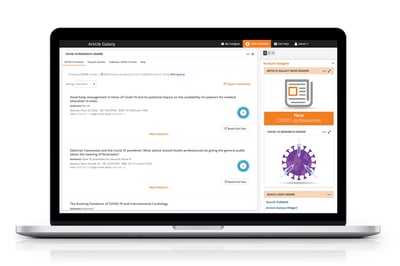For life sciences companies that focus on clinical and product development, the disruptions created by the COVID-19 crisis have been sweeping. When the pandemic hit in early 2020, many pharmaceutical and biotechnology companies across the globe quickly pivoted operations to focus on developing COVID-19 drugs, therapeutics, and vaccines.
At the same time that these pharma and biotech companies were pivoting their operations, however, they’ve also had to adapt to a host of new challenges—such as moving to remote work environments and protecting the health of employees, while conducting critical clinical trials and enabling essential collaboration among scientists.
Productivity & Priorities
In many industries, post-pandemic studies have shown an increase in productivity when people work from home versus in the office. For scientists who need to be in the laboratory to conduct their research, however, it's a different story. In adjusting their R&D operations, biotech and pharma companies have had to carefully weigh the need to protect scientists and employees, while continuing the development of essential life-saving drugs and therapeutics.
According to a May 2020 McKinsey article, companies have seen an estimated 25% - 75% drop in R&D productivity due to COVID-related disruptions.
Similarly, a survey of life scientists published in Genome Biology found that only 29% of dry lab scientists and a mere 10% of wet lab scientists were able to carry out their work from home with “at least 80% productivity.”
In the months following the COVID-19 lockdowns, a study by the National Bureau of Economic Research found that the average workday increased by almost an hour (across industries, in cities worldwide). Interestingly, the previously-noted Genome Biology survey revealed that manuscript submissions to scientific journals increased significantly during the first few months of the pandemic as well.
While 49% of scientists said their research hours had been reduced due to COVID-related shutdowns, many reported devoting more time to data analysis, manuscript or thesis writing, or developing grant applications.
Amid the pandemic, many journals have expedited their review processes to enable faster publication, and most scholarly journal publishers have enabled rapid, open sharing of COVID-19 content.
Collaboration
Collaboration is an important element of scientific research in normal times. But during a global pandemic, it becomes ever more critical.
This year, however, scientists have not been able to connect and collaborate with colleagues in traditional ways due to lab shutdowns and cancelled industry conferences. But the scientific research community has found new ways to collaborate.
In a remarkable global effort to accelerate the development of a COVID-19 vaccine, scientists have turned to technology, like video conferencing tools, to share resources, research, and data. Indeed, according to the Genome Biology article mentioned earlier, 94% of the life scientists surveyed reported “ample use of VC to collaborate, discuss, and develop science.”
Clinical Trials
Diminished access to clinical sites has created major obstacles for clinical trials. As a result, many studies deemed lower priority (e.g. gastrointestinal trials) have been paused or delayed in order to focus more efforts and resources on studies related to COVID-19, as well as other high priority clinical areas like oncology.
Pharma and biotech companies have found new ways to keep the trials they deemed “essential” running. For example, many companies are using telehealth technologies to conduct virtual patient visits, as well as remote monitoring and home-based testing systems, which allow researchers to collect vital signs and other data remotely. To further protect trial participants from the coronavirus, drugs are often shipped directly to patients’ homes, and patient samples are collected via curbside pickup and/or courier delivery.
Employee Health & Safety
Preventing the spread of COVID-19 among researchers, scientists and other employees has been a top priority for life sciences companies amid the pandemic. In some cases, facilities have been closed and employees are working remotely. But much of the essential work can only be done onsite, in the lab.
For scientists and other employees (including, for example, those who work in drug manufacturing plants), companies have had to take extra precautions, such as requiring temperature checks before entering the facility; requiring personal protective equipment; and staggering shifts to enable safe social distancing.
Looking Ahead
In many industries, remote work is no longer viewed as a productivity drain, and many are looking into a more permanent remote work structure. But what's undeniable is that many of the new tools, protocols and technologies put in place during the COVID-19 crisis will likely have a lasting, positive impact. Although the value of in-person conferences and collaboration will always prove valuable, remote collaboration technologies create new efficiencies for today’s global research landscape. Similarly, advances in virtual clinical trial management, which allowed high-priority R&D studies to continue in the face of pandemic restrictions, have the potential to transform the way trials are conducted in the future—offering a more patient-centric experience.
Today, we seem on the precipice of vaccine approval, with daily news of multiple COVID-19 vaccine candidates proving safe and effective. Here at Research Solutions, we'd like to express our sincere thanks to the pharma and biotech companies—and all the scientists around the world—who have been leading the charge, working through unprecedented operational challenges to help bring the outbreak to an end.
Leah Rodriguez | VP of Marketing
Leah has over 17 years of experience in publishing and software with various roles leading and developing marketing teams. Prior to joining Research Solutions, she was at Nature Publishing Group, launching marketing for their open access journals, Nature Communications and Scientific Reports and at PLOS, developing...


